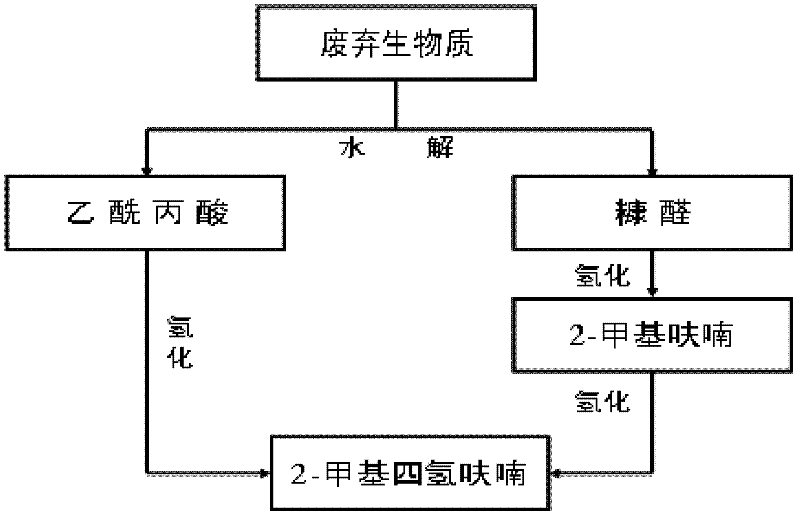Method for preparing 2-methyltetrahydrofuran from waste biomass
A technology of methyl tetrahydrofuran and waste biomass, applied in the direction of organic chemistry, etc., can solve the problems of low production capacity of 2-Me-THF, the overall production capacity is less than 5,000 tons, and the price of products remains high, and achieves low cost and good economic benefits. , the effect of improving productivity
- Summary
- Abstract
- Description
- Claims
- Application Information
AI Technical Summary
Problems solved by technology
Method used
Image
Examples
Embodiment 1
[0032] 1. Preparation of furfural and levulinic acid
[0033] 1. Raw material pretreatment:
[0034] After crushing soybean straw with a moisture content of 15% into 0.5-1cm fragments, adding tap water, stirring and mixing to obtain a biomass slurry with a moisture content of 65%, wherein the weight ratio of tap water to soybean straw is 1: 1;
[0035] 2. The first step acid hydrolysis reaction:
[0036] Put the above-mentioned biomass slurry into a premix tank, add concentrated sulfuric acid (mass percentage concentration is 98%) in the tank, and after mixing evenly, send the slurry sulfuric acid mixture into the first reactor with a plunger type high-pressure pump. The bottom of the reactor is fed with high-temperature and high-pressure steam to increase the temperature and pressure in the first reactor, and the first step of acid hydrolysis reaction is carried out to obtain the first step to acid hydrolysis mixture. The mass ratio of biomass slurry to concentrated sulfuri...
Embodiment 2
[0081] 1. Preparation of furfural and levulinic acid
[0082] 1. Raw material pretreatment:
[0083] After crushing sunflower shells with a moisture content of 15% into 0.5-1cm fragments, adding tap water, stirring and mixing to obtain a biomass slurry with a moisture content of 60%, wherein the weight ratio of tap water to soybean straw is 0.82: 1;
[0084] 2. The first step acid hydrolysis reaction:
[0085] Put the above-mentioned biomass slurry into a premix tank, add concentrated sulfuric acid (mass percentage concentration is 98%) in the tank, and after mixing evenly, send the slurry sulfuric acid mixture into the first reactor with a plunger type high-pressure pump. The bottom of the reactor is fed with high-temperature and high-pressure steam to increase the temperature and pressure in the first reactor, and the first step of acid hydrolysis reaction is carried out to obtain the first step to acid hydrolysis mixture. The mass ratio of biomass slurry to concentrated s...
Embodiment 3
[0124] 1. Preparation of furfural and levulinic acid
[0125] 1. Raw material pretreatment:
[0126] After crushing corncobs with a moisture content of 20% into fragments of 0.5-1 cm, adding tap water, stirring and mixing to obtain a biomass slurry with a moisture content of 60%, wherein the weight ratio of tap water to soybean stalks is 0.67: 1;
[0127] 2. The first step acid hydrolysis reaction:
[0128] Put the above-mentioned biomass slurry into a premix tank, add concentrated sulfuric acid (mass percentage concentration is 98%) in the tank, and after mixing evenly, send the slurry sulfuric acid mixture into the first reactor with a plunger type high-pressure pump. The bottom of the reactor is fed with high-temperature and high-pressure steam to increase the temperature and pressure in the first reactor, and the first step of acid hydrolysis reaction is carried out to obtain the first step to acid hydrolysis mixture. The mass ratio of biomass slurry to concentrated sulf...
PUM
 Login to View More
Login to View More Abstract
Description
Claims
Application Information
 Login to View More
Login to View More - R&D
- Intellectual Property
- Life Sciences
- Materials
- Tech Scout
- Unparalleled Data Quality
- Higher Quality Content
- 60% Fewer Hallucinations
Browse by: Latest US Patents, China's latest patents, Technical Efficacy Thesaurus, Application Domain, Technology Topic, Popular Technical Reports.
© 2025 PatSnap. All rights reserved.Legal|Privacy policy|Modern Slavery Act Transparency Statement|Sitemap|About US| Contact US: help@patsnap.com



